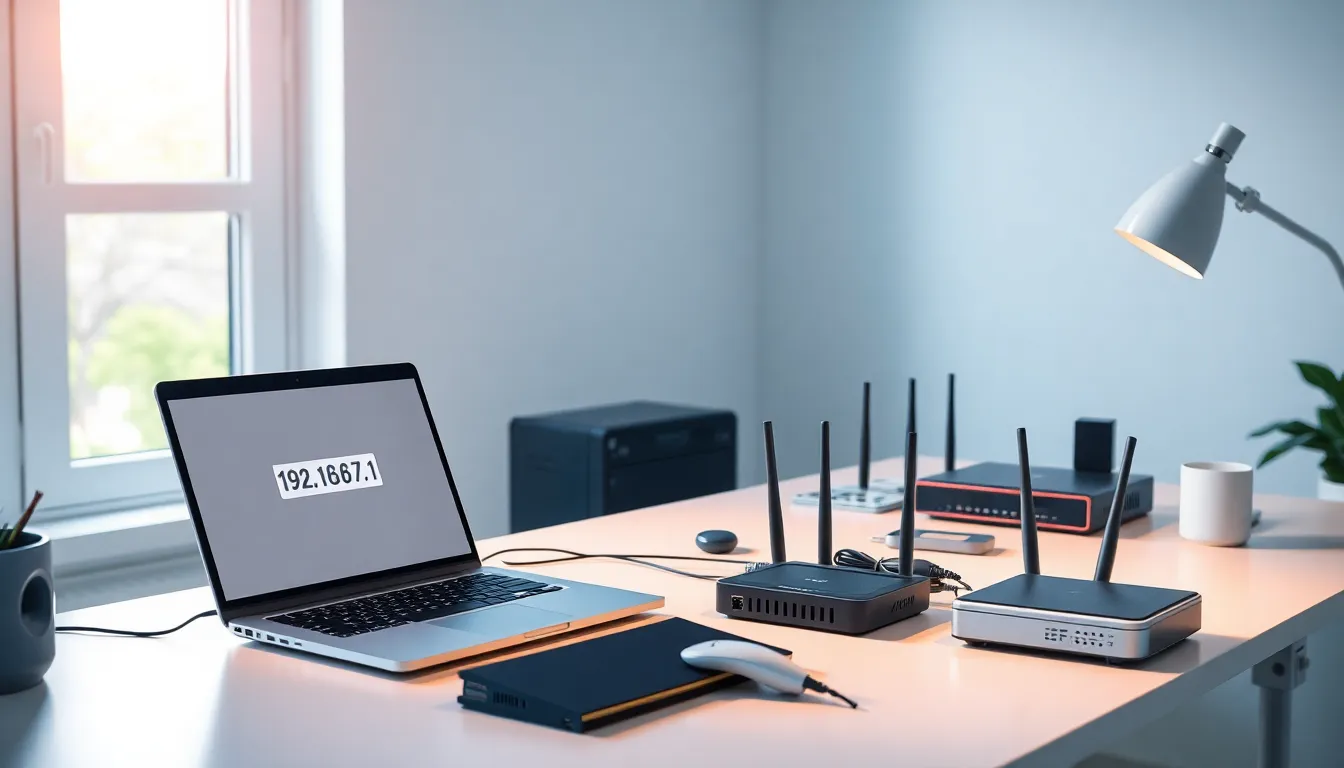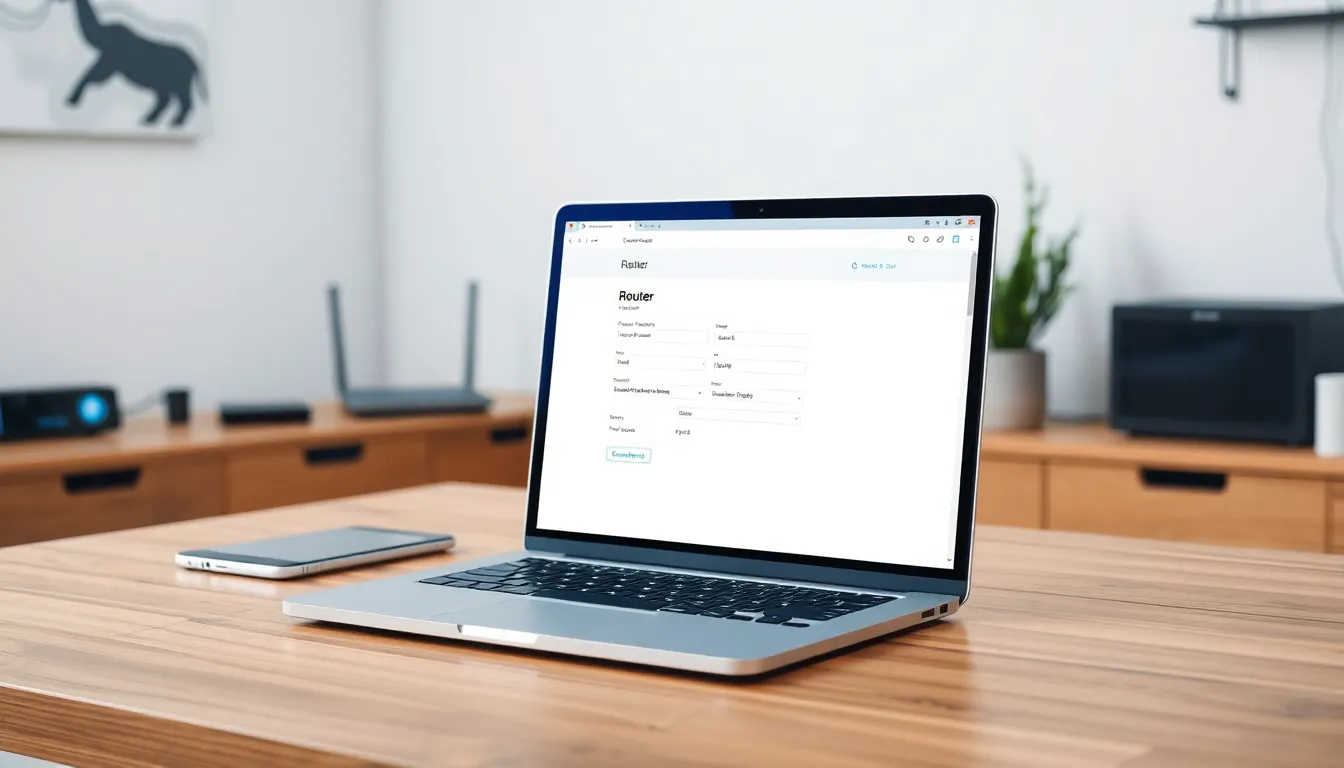Table of Contents
ToggleIn the vast universe of IP addresses, 192.168.7.1 stands out like a quirky neighbor with a pet llama. It’s more than just a series of numbers; it’s the gateway to your home network, the secret portal to managing your router settings, and the unsung hero of your internet experience. If you’ve ever found yourself tangled in the web of connectivity issues or just wanted to customize your Wi-Fi, this address is your trusty sidekick.
Understanding 1921687.1
192.168.7.1 serves as a private IP address primarily used in local networks. This address plays a significant role in configuring devices linked to home routers. Administrators access this address through a web browser, enabling them to manage and personalize network settings effectively.
Commonly, users encounter this IP address when setting up a new router or troubleshooting network issues. Issues like slow connectivity or device disconnections prompt individuals to access the router settings via 192.168.7.1. Specific users can enhance their network experience by adjusting settings such as Wi-Fi passwords and security protocols.
Devices on the same local network typically recognize and communicate with 192.168.7.1 without complications. This ease of access makes it a vital component for network management. For example, altering the default login credentials promotes enhanced security for network users.
Equipped with the correct username and password, users navigate directly to the router’s configuration page. Once logged in, users can observe vital statistics, such as connected devices and bandwidth usage. This information aids in identifying performance issues and areas needing improvement.
In structured networks, the address allows for easier identification and management of individual devices. It connects computers, smartphones, and other smart devices efficiently. Understanding the functionality of 192.168.7.1 empowers users to optimize their home network effectively. Familiarity with this address leads to a more reliable and efficient internet experience.
The Basics of IP Addressing

Understanding IP addressing is crucial for anyone managing a network. It represents a unique identifier for devices connected to a network, allowing for communication between them.
What is an IP Address?
An IP address serves as a numerical label assigned to each device on a network. This unique identifier permits devices to locate and communicate with each other. Two primary versions exist: IPv4 and IPv6, with IPv4 being the most widely used. Each IPv4 address consists of four decimal numbers separated by periods, like 192.168.7.1. This structured format helps routers direct data traffic effectively, ensuring smooth connectivity.
Types of IP Addresses
IP addresses fall into two main categories: public and private. Public IP addresses identify devices on the internet, enabling connections beyond local networks. In contrast, private IP addresses, such as 192.168.7.1, operate within local networks, ensuring that devices can communicate without external interference. A local area network utilizes these private addresses to manage devices like routers, printers, and computers more efficiently. Understanding these types equips users to make informed decisions when configuring their home or office networks.
Accessing the 1921687.1 Interface
Accessing the 192.168.7.1 interface enables users to manage their network settings effectively.
Steps to Connect
Connecting to this address involves a few straightforward steps. First, users should ensure their device connects to the network associated with the router. Next, opening a web browser is crucial for the process. Entering “192.168.7.1” into the address bar directs the user to the login page of the router. Inputting the router’s username and password allows access to the configuration settings. If the default credentials haven’t changed, referring to the router’s manual can provide this information. Once logged in, users can explore various settings to optimize their network experience.
Troubleshooting Connection Issues
Connection issues can arise during the accessing process. First, verifying the network connection is essential; users should check if their device connects to the correct Wi-Fi network. Next, ensuring the browser is updated aids in loading the page correctly. Clearing the browser’s cache can help resolve loading issues. In cases where the login credentials fail, users can reset the router to its factory settings to regain access. If problems persist, consulting the router’s support page or contacting customer service may offer solutions.
Configuring Settings on 1921687.1
Configuring settings on 192.168.7.1 provides users with essential options to enhance their network experience. Accessing the router’s interface opens a range of configuration possibilities.
Changing Default Passwords
Changing default passwords represents a fundamental step in network security. Users should immediately replace the factory-set credentials with unique alternatives. Doing this protects the router from unauthorized access. Navigating to the settings menu allows adjustments, ensuring the new password meets security guidelines. Opting for a combination of letters, numbers, and special symbols increases password strength. Regularly updating passwords enhances overall security as well. Following these steps aids in safeguarding personal information and optimizing internet use.
Managing Network Settings
Managing network settings offers control over various aspects of a home network. Users can customize Wi-Fi names, known as SSIDs, to make connections easier for family members. Adjusting security protocols like WPA3 strengthens the overall network safety. Bandwidth allocation settings allow prioritization for specific devices, ensuring smoother performance for important tasks. Users gain insight into connected devices and their usage statistics through the interface. Regular checks on these settings help maintain an efficient network environment. Awareness and adjustments lead to a more stable and reliable internet connection.
Security Implications of Using 1921687.1
Using 192.168.7.1 as a gateway for router configuration raises multiple security considerations. Users should prioritize changing default passwords immediately after installation. Factory-set credentials often lack complexity, making unauthorized access easier for attackers.
Ensuring the network is secure requires monitoring connected devices. Administrators can leverage the configuration interface to identify unknown devices that may be intruders. Regularly reviewing these connections helps in maintaining network integrity.
Implementing strong security protocols is essential. Configuring WPA3 encryption strengthens protection against unauthorized access significantly. Users can enhance safety by routinely updating security protocols based on evolving threats.
Employing firewall settings further fortifies the network. Routers equipped with built-in firewalls offer additional layers of protection. Users should check and configure these settings to ensure appropriate filtering of incoming and outgoing traffic.
Managing firmware updates cannot be overlooked. Router manufacturers frequently release updates to address vulnerabilities and security flaws. Administrators should schedule periodic checks to install the latest firmware versions, minimizing risks associated with outdated software.
Having a guest network can also improve overall security. Isolating guest devices from the main network reduces the chances of sensitive information exposure. Users can set up temporary access for visitors while safeguarding personal data on their primary devices.
Ensuring secure remote access is pivotal for users who manage their networks off-site. Implementing VPNs can protect data traffic, particularly when accessing the router from public networks. Utilizing these security measures bolsters overall network security when using 192.168.7.1.
Mastering the use of 192.168.7.1 is essential for anyone looking to optimize their home network. This private IP address not only simplifies device management but also enhances security when configured correctly. By changing default passwords and implementing strong security measures, users can protect their networks from unauthorized access.
Regularly monitoring connected devices and updating router firmware ensures a stable and secure internet connection. Whether troubleshooting connectivity issues or customizing network settings, understanding 192.168.7.1 empowers users to create a more efficient and reliable online experience. Embracing these practices leads to a well-managed network that meets the demands of modern digital life.




